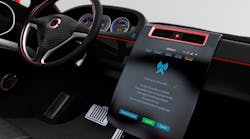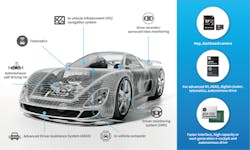Only NAND Flash Meets the Data-Driven Demands of Next-Gen AVs and EVs
What you’ll learn:
- The widespread adoption of NAND storage in automotive applications.
- What do automotive manufacturers expect their chosen NAND storage device to offer?
Today’s modern vehicles are full of compute, sensors, memory, and storage that not only enhance the driving experience, but help usher in the era of autonomous and electric vehicles.
Regardless of its level of autonomy and electric-vehicle design, the average car on the road is becoming its own data center. The need for data storage has grown exponentially, and so has the role of NAND-flash storage in automotive applications to support mission-critical functions and entertainment features. These devices must be able to ensure the level of performance, reliability, and longevity required by automakers.
In addition to meeting automotive-grade qualifications, storage devices are expected to last for as long as the vehicle is on the road.
NAND-flash storage solutions such as embedded multimedia card (eMMC), Universal Flash Storage (UFS) and solid-state drives (SSDs) have experienced proven successes in smartphone, consumer, and enterprise storage applications. Now, they are readily being adopted by automakers, Tier 1 systems designers, and other key stakeholders in the automotive supply chain for performance, reliability, longevity, and security considerations.
Evolution of Automotive Storage
Electronic components in motor vehicles have a long history that have put cars on a course to become more data-centric.
According to current research, roughly 90 million cars will be collecting data from sensors and making it available online by 2025. Today’s vehicle brings many advanced “infotainment” features together in a single cockpit dashboard—screens that entertain and provide critical information to the driver to ensure safety and even help them drive.
Screens are getting bigger; some stream music, video, and even gaming for passengers, and the GPS is built right into the vehicle along with other advanced driver-assistance systems (ADAS). Many ADAS features collect data from sensors, cameras, radar, and LiDAR. Although the amount of data for each feature can be small, it adds up.
Autonomy, even if only partial, adds a great deal of data to the mix. ADAS features such as lane keeping, automatic braking, and adaptive cruise control are data-dependent features. And fully autonomous driving that requires no human intervention at all will require data for the automatic decision-making to happen.
Connectivity also is driving up data storage requirements on vehicles. Whether it’s Wi-Fi or 5G, connectivity makes it easier to upgrade onboard software. When software becomes easier to upgrade, it’s more likely to be added to a vehicle in the form of new features, bug fixes, and security patches.
In addition, the modern vehicle comes equipped with a great deal of diagnostics capabilities that could become remote accessible. Like a commercial aircraft, cars have their own black boxes to record what happens during an accident and the moments leading up to it.
Storage is needed to capture data such as steering input, G-forces on the car, speed, telemetry, and even video and audio. Requirements for storage become more specific because a large, sudden burst of data must be quickly written to the device. That storage device must be durable enough to survive a serious impact, and even fire or water damage.
A key design trend in the architecture of intelligent vehicles is the consolidation of many computing capabilities so that the storage can serve a variety of applications in the functions of vehicles—while being smart enough to know what takes priority. For example, autonomous functions and entertainment applications might share the same storage pool.
Because of the ever-growing quantities of digital data that must be processed and stored, automotive system designers now prefer NAND-flash devices over rotational media for mass storage due to their reliability and tolerance for wide temperature ranges as well as large capacities in small form factors. Any NAND-flash storage device must keep pace with capacity, latency, and performance requirements delivering fast read and write speeds and high data throughput.
Despite this consolidation, a variety of different NAND storage types will be available to support the required data-storage demands in autonomous and electric vehicles.
NAND Storage in Modern Automotive Designs
When NAND flash was still quite expensive and had not attained the densities and cost structures we see today, hard drives using rotational media were seen as the best solution to storing data in cars. Automotive-grade hard drives were designed to handle temperature extremes and vibration as well as withstand shock loads as high as 200X the force of gravity and more. They also were inexpensive given the amount of data they could store in a small space. However, hard drives have relatively slow access times and are subject to shock and vibrational failures.
But as the cost of NAND flash came down and solid-state storage designs matured, they began to make more sense and replace rotational media. A clear advantage for NAND storage over hard drives is the lack of moving parts, which makes them less likely to fail due to shock and vibration. NAND storage also is much faster than a hard drive and can handle the extreme temperatures ranges of automotive applications.
NAND flash finds its way into the modern vehicle in so many ways to support a wide range of applications. The types of NAND-flash storage in the vehicle depends on application performance and capacity requirements. CompactFlash and Secure Digital cards remain flexible options for automotive applications such as digital maps and dash cameras. These removable storage types enable the flexibility of aftermarket content upgrade and retrieval.
NAND storage in the form of eMMC was the first type of solid-state storage to be extensively adopted in automotive applications. Widely deployed in mobile phones, this non-removable memory card is soldered onto a circuit board, making it secure against constant vibrations. eMMC continues to be a viable choice for storing data related to many navigation and infotainment applications, including satellite radio, 3D maps, traffic monitoring, and weather information.
The emergence of the UFS interface has seen it usurp eMMC for newer automotive designs, as it was specifically developed to be a high-performance replacement for eMMC. It offers a faster interface, higher density, better power efficiency, and higher performance for reads and writes in comparison to eMMC. UFS also offers fast boot times—systems start up as fast as it takes for the driver to turn the key in the ignition.
The more computational needs of an automotive design have pushed data-storage requirements even further in terms of performance and storage capacity. This has led to the adoption of higher-capacity NAND-flash storage in the form of full-blown SSDs that are automotive-grade, which means they’re designed to handle enterprise equivalent performance and capabilities while supporting extreme temperature ranges. Moreover, the larger capacities allow for the consolidation of storage within the automotive system to reduce the overall number of storage devices required.
Automotive-grade SSDs are moving from SATA to the PCIe NVMe interface as more vehicles with advanced autonomous-driving capabilities are sold. They require as much as 1 TB of flash storage for 3D maps, 4K infotainment content, sensor data, and black-box recording, all of which increase demands for more bandwidth, latency, and capacity.
NAND Storage Requirements for Automotive
NAND-flash storage devices for automotive applications should be tailored for the functions found in the modern vehicle—this is mainly enabled by the NAND controller technology designed with automotive applications in mind. The NAND controller is essentially the “brains” of a storage device. It plays a key role in optimizing the various NAND-flash storage for automotive applications by ensuring performance, reliability, and security, as well as supporting the various 3D NAND-flash technologies.
eMMC, UFS, and SSD controllers share many of the same capabilities as those controllers for other applications. Controllers used for automotive, however, are usually manufactured on an automotive process by the semiconductor foundries, support extended temperature, exhibit low defected parts per million (DPPM), and are designed with Automotive Software Performance Improvement and Capability dEtermination (ASPICE) standard compliance in mind.
Whether it’s just a controller or full-blown storage device, any automotive-grade flash product must demonstrate it has undergone rigorous testing to meet the qualifications expected by automakers, including AEC-Q100 compliance as well as ISO 9000/9001 and ISO 26262 certification.
Conclusion
Automotive designs are evolving for modern autonomous and EV vehicles and, in turn, so are the respective storage systems. Because NAND flash finds its way into the modern vehicle in so many ways to support such a wide variety of applications, automotive manufacturers expect their chosen NAND storage device to have the required performance and reliability with data retention to match life of the vehicle.
Thus, they should turn to a vendor with a robust portfolio of tailored flash storage and controller solutions optimized to support infotainment, navigation, ADAS, and self-driving applications, as well as being future-proofed to support the evolution of the data center on wheels.

